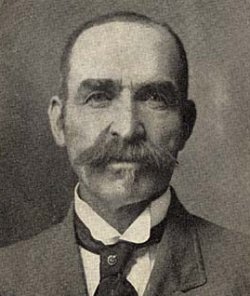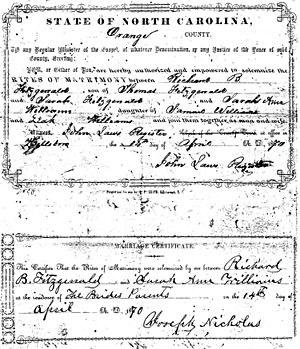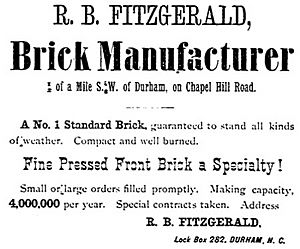Richard B. Fitzgerald facts for kids
Richard Burton Fitzgerald (born around 1843 – died March 24, 1918) was an American brickmaker and businessman from Durham, North Carolina. He built a successful brick-making company. Later, he became the president of Mechanics and Farmers Bank, a bank owned by African Americans in Durham. He was also involved in many other businesses across North Carolina.
Fitzgerald was the first president of the Coleman Manufacturing Company. This company, started in 1897, was the first cotton mill in the United States owned and run by Black people. His bricks were used to build many important buildings in North Carolina's biggest cities, including the state capital.
Richard Fitzgerald was born free in New Castle County, Delaware. His mother was white, and his father was mixed-race and had been freed from slavery. In 1855, his family moved to Chester County, Pennsylvania. They did this to protect their children from slave catchers. These catchers could take free Black people and sell them into slavery under the Fugitive Slave Act of 1850.
After the American Civil War, where he served, Fitzgerald joined his family in Hillsborough, North Carolina. They started a brickyard on their farm there. Richard later moved to Durham with his brother. He built his business and became a very important person in Durham's Black community.
Contents
Richard Fitzgerald's Early Life and War Service
Richard Fitzgerald was born free around 1843 in New Castle County, Delaware. His parents were Thomas and Sarah (Burton) Fitzgerald. His father, Thomas, was mixed-race, with both African and Irish roots. He had been freed from slavery. Richard's mother was white and had English family. She chose to raise her sons as proud members of the free people of color community.
Richard was described as a "sturdy, rough and tumble fellow." He loved having fun more than studying. His great-niece, Pauli Murray, wrote about him:
"Fiery, red-faced blond Richie had the same sharp blue eyes and shrewd trader's head as his mother. He was quick to drive a hard bargain and even quicker with his fists. His hot temper led him into many skirmishes and even as an old man he used to laugh and say, 'By golly, if I was dying and somebody made me mad, I'd stop dying long enough to fight about it.'"
At night, his brother Robert, who was more interested in school, would teach Richard and their other siblings what he had learned. Richard and his brother William ("Billy") worked in their father's brickyard instead of going to the local Quaker school.
In 1855, the Fitzgerald family moved to a 25-acre (100,000 m2) farm near Hinsonville in Chester County, Pennsylvania. They moved to keep their children safe from slave catchers. These catchers were very active after the Fugitive Slave Act of 1850 offered rewards for catching runaway enslaved people.
When the American Civil War began, Fitzgerald joined the Quartermaster Corps as a civilian worker in Philadelphia. At first, Black people were not allowed to be soldiers. In 1862, he moved to the Army of the Potomac's supply base in Washington. He drove mules for the Union army. He spent most of 1862 near Harrison's Landing and Fort Monroe. In 1863, the United States Colored Troops were formed, allowing Black men to serve as soldiers. Later in the war, Fitzgerald "went to sea," likely working as a merchant seaman.
Building a Business After the War
In late 1869, Fitzgerald and his brother Billy joined their family in Hillsborough, North Carolina. The family had moved from Pennsylvania and bought land there. The brothers started a brickyard on the family farm. Their father and brother Robert helped them.
However, the country was facing money problems, and there was a bad drought in the area. The Fitzgerald brick business made 40,000 bricks, but they couldn't find anyone to buy them. The brothers tried to sell their bricks in Raleigh, but it didn't work. Billy went back to Pennsylvania after only a few months.
Richard also felt discouraged and returned to Pennsylvania. But his brother Robert found success. Robert got an order for 4,000 bricks for railroad improvements. He also got a big contract to make 4,000,000 bricks for the new state prison in Raleigh. Robert wrote to Richard and Billy about these contracts, convincing them to come back to North Carolina.
They started the contracts in the spring of 1870. They hired a team to help make the bricks. They went to Raleigh and set up their brick production site. But a sudden flood destroyed thousands of bricks. Billy left for Pennsylvania again. Richard and Robert saved some of the bricks. They then made 525,000 more. They were paid eighty-five cents for every thousand bricks. After paying their debts and workers, they made a profit of $83.10 for four months of work.
Marriage and Family Life
On April 4, 1870, Richard married Sarah ("Sallie") Ann Williams at her parents' home. They had at least 12 children together. Their sons included Charles, Samuel, Richard, Burton ("Burke"), and William. Their daughters included Lilly, Sarah, Leer, Susan, Beatrice, Alma, and Irene. Two of their sons, Burke and Samuel, followed their father into the brickmaking business. Samuel continued the family business after his father passed away.
Moving to Durham and Growing the Business
Several years later, in 1879, Richard Fitzgerald and his brother Robert moved their families to Durham. They saw good chances for business there because of the growing tobacco industry. Richard Fitzgerald bought a large piece of land in Durham that had good clay for making bricks. He started a brickyard there and built a big eighteen-room house.
According to his grandniece, Pauli Murray, "Within the next fifteen years Uncle Richard became Durham's leading brick maker." By 1884, he had a large brickyard and orders for two million bricks. His brick company was located at the corner of Fitzgerald Street and Chapel Hill Road.
A tobacco maker named William T. Blackwell promised to buy all the bricks Fitzgerald made. By 1910, Fitzgerald was making "30,000 brick a day from his $17,000 plant." He also owned 100 acres (0.40 km2) of land within the city and had $50,000 worth of real estate. W.T. Bost, a newspaper editor, said that Fitzgerald "makes better brick than any other man in town; therefore the people buy Fitzgerald's brick."
After 30 years of making bricks, Fitzgerald had a large brickyard with a $6,000 cement dryer. This dryer allowed him to make bricks all year round. His brickyard could produce 30,000 bricks per day. In 1913, his total property was valued at $100,000. He was smart with his money. For example, he bought a piece of land for $1,500 and sold it five years later for $6,000. He also bought forty acres of farmland for $800, made bricks on it for ten years, and then sold it for $3,000.
Besides making bricks, Fitzgerald was involved in many other businesses. In 1885, he bought printing equipment to start a newspaper for the African-American community in Durham. It is not known if he published any issues. In 1895, Fitzgerald and four other people started the Durham Drug Company. It was renamed the Fitzgerald Drug Company in 1901 and operated until 1910. Also in 1901, Fitzgerald became the treasurer for Lincoln Hospital, which was founded for African Americans.
In 1898, Fitzgerald became the first president of the Coleman Manufacturing Company in Concord, North Carolina. This was a very important step. It was the first cotton mill in the United States that was built, owned, and run by Black people. W. C. Coleman and other partners from Wilmington, North Carolina named the company after him.
Fitzgerald also served as president of the Durham Real Estate, Mercantile, and Manufacturing Company. This company was started in 1899 to help promote businesses for African Americans.
Fitzgerald was one of the first people to help create the Mechanics and Farmers Bank. This bank received its official permission from North Carolina in 1907. It opened its office in 1908 in the North Carolina Mutual Life Insurance Company Building on Parrish Street. This area was known as "Black Wall Street" because of its many successful Black-owned businesses.
Death and Recognition
Richard Fitzgerald passed away on March 24, 1918. He is buried in what is called the Fitzgerald section of the Maplewood Cemetery in Durham. This section was originally a private cemetery on the land around his large house. It later became part of the Maplewood Cemetery.
In 2019, Richard Fitzgerald was honored by the Sesquicentennial Honors Commission in Durham, NC. He was recognized along with C.C. Spaulding Sr. and John Merrick. They were honored for their important contributions to Durham. They were innovative leaders who helped create one of the strongest African American business communities in the country.
Buildings Made with Fitzgerald Bricks
Here are some important buildings constructed using bricks made by Richard Fitzgerald:
- Central Prison; Raleigh (built between 1870 and 1884)
- Emmanuel AME Church; Kent Street, Durham (built 1888)
- St. Joseph's AME Church (now Hayti Heritage Center); Fayetteville Street, Durham (built 1891)
- Erwin Cotton Mills; West Main and Ninth streets, Durham (built 1892)
- Fitzgerald Building; corner of Chapel Hill and Kent streets, Durham (built 1910)






